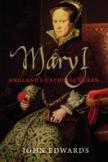The Battle for England's Soul
The short reign (1553-58) of England’s Queen Mary I witnessed the execution of an astonishing 284 people for their Protestant beliefs, earning her the nickname Bloody Mary. This moniker has attached to her reputation ever since. Mary has unjustly suffered from an insular approach to English history, as her five-year reign appeared as a bump on the road toward staunch English Protestantism. Mary’s father, Henry VIII, had broken with Rome in 1534 because the pope refused to annul his marriage to her mother, Catherine of Aragon.
During the equally brief reign of Mary’s younger half-brother, Edward VI (1547-53), the English church drifted toward Protestantism. Mary was accused of attempting to restore medieval religion to England; and, as England’s first female sovereign, she was faulted for her lack of political prowess and her single-mindedness. John Edwards’s new biography of Mary I takes an ecumenical approach, building upon and advancing the recent revisionist efforts of Catholic and women scholars to re-evaluate Mary’s rule in both the religious and the secular spheres.
As both a distinguished British historian of early modern Spain and an Anglo-Catholic by faith, Edwards has the background to recast Mary’s life in a European context. He argues that Catherine of Aragon ensured that Mary received the full formal education in Latin and Greek that a male heir to the throne would have received, primarily under the tutelage of the Spanish humanist Juan Luis Vives. Mary was immersed in the Bible, the church fathers, classical authors and the works of Vives’s humanist acquaintances, Erasmus and Thomas More. Mary’s humanist education influenced her religious practice, which eschewed traditional pilgrimages and relics—criticized by the humanists—and emphasized the Mass, eucharistic devotions and meditations on the life and passion of Christ, like Thomas à Kempis’s Imitation of Christ. Her Christocentric piety was nourished by the same texts that were the foundation of both Ignatian and Catholic Reformation spirituality.
Edwards asserts that the queen’s restoration of the Catholic religion, like her personal piety, was not reactionary but was based upon the ideas of leading reformers. He recounts how Mary attempted to reform English Catholic religion by requiring bishops to reside in their diocese, encouraging preaching, founding seminaries, publishing catechetical works and even planning an English translation of the Bible. Cardinal Reginald Pole, archbishop of Canterbury, devised and undertook these reforms of the English church. Pole had long been active in Catholic reform in Rome, and his legislation establishing a seminary in every diocese became the basis for the Council of Trent’s important decree on seminaries. Mary had also, before Pole arrived, replaced the Protestant bishops of Edward’s reign with both Catholic-leaning bishops who had accepted Henry’s break with Rome and bishops loyal to Rome.
Mary’s progressive reforms prove (although Edwards does not let the reader know this) that English historians were wrong to argue that the so-called Marian Reaction was founded solely on coercion and could never have evolved into a workable form of English Catholicism. While Edwards emphasizes Pole’s and Mary’s reform plans, he disagrees with Eamon Duffy’s recent claim that Mary’s heresy trials were effective methods of re-establishing English Catholicism, arguing instead that they were counterproductive to Mary’s reform aims. Nevertheless, Edwards connects Mary’s reforms to nascent trends in the European church, holding forth the possibility that England could have been reconverted to a reformed Catholicism through persuasion rather than violence—something that the Counter-Reformation church accomplished in parts of Germany and elsewhere.
Edwards also undermines English insularity by considering European models of female royal authority. He compares Mary to her grandmother Isabella of Castile, not, as most everyone else does, by contrasting her with her half-sister and successor as queen of England, Elizabeth I. The strong-willed and deeply pious Isabella of Castile successfully ruled a united Spain with her husband, Ferdinand of Aragon, while still governing Castile in her own right. She thus set a precedent for Mary, who ruled England even after her marriage to Philip of Spain in 1554.
Mary lived much of her life among Spanish officials and courtiers, and also shared the determination and strong convictions that served her grandmother well as a female ruler in a man’s world. The author also places the major events of Mary’s reign—her marriage to Philip of Spain and England’s war with France—in their full, if somewhat dizzying, European context. England became a pawn in the power politics of Europe, disastrously losing Calais, its last territory in France, while the pope, fighting his own war against Philip and his Hapsburg allies, tried to diminish Cardinal Pole’s power by calling him to Rome to face charges of heresy. These misfortunes of Mary’s reign, Edwards argues, were largely out of Mary’s control as England was marginalized by the struggle between the pope and the sprawling Hapsburg Empire.
The author is right to study Mary’s life, religion and reign in a European context, but unfortunately Mary herself is somewhat lost in the details. Dynastic marriage plans, the to and fro of diplomatic negotiations, continental politics and romanticized Spanish views of England and the English—interesting and important in their own right—are not sufficiently integrated into the narrative of Mary’s life to reveal all that they might about her views.
While Edwards deserves credit for bringing neglected Spanish sources to the account of Mary’s life, he fails to explain what difference these sources make for our understanding of Mary’s character. The challenge of replacing the colorful, if historically false, image of a fanatical and politically inept Bloody Mary with a balanced yet equally compelling image of Mary is daunting. Edwards frees Mary from the limiting perspective of English history, but fails to imaginatively craft a worthy portrait of Mary that will command the place she deserves on the wide European canvas.
This article also appeared in print, under the headline “The Battle for England's Soul,” in the November 7, 2011, issue.








